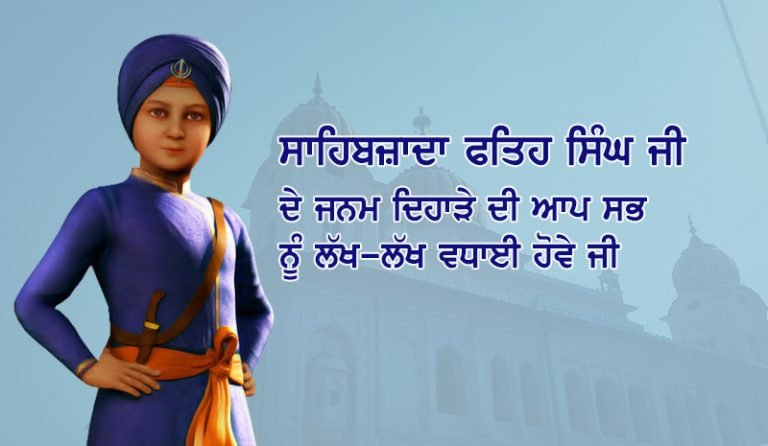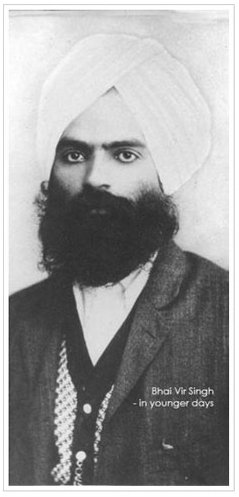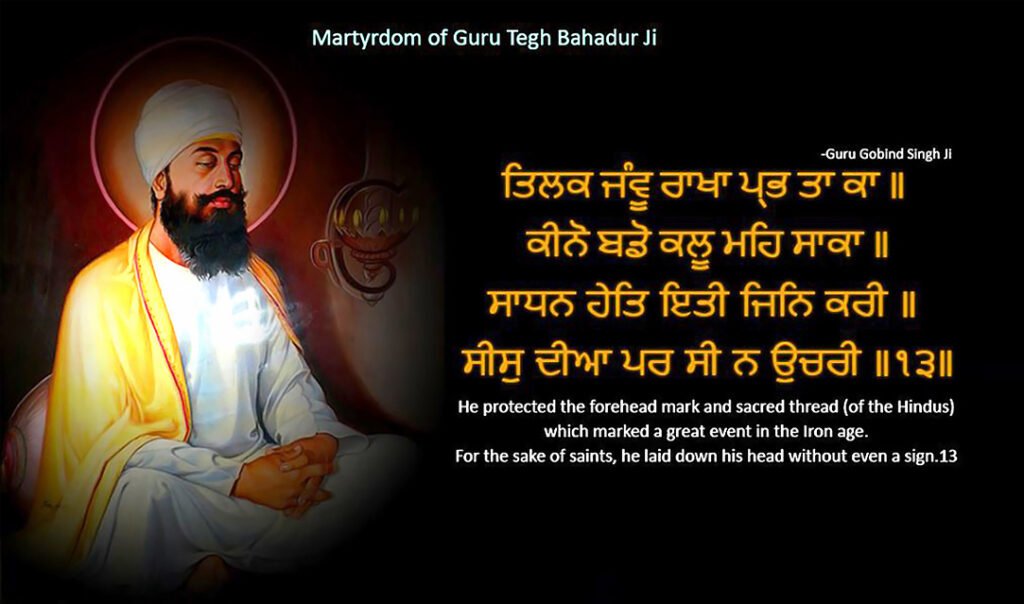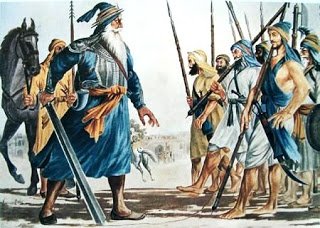Guru Har Gobind Ji had five sons and one daughter. The eldest son was Baba Gurditta Ji who had two sons, Dhir Mal and Har Rai. Dhir Mal turned out disloyal and disobedient. He had some influence in the court of Emperor Aurangzeb and was in communication with the Guru’s enemies. When Guru Har Gobind Ji moved to Kiratpur, Dhir Mal with his mother, remained at Kartarpur and took possession of the Guru’s property and also of the priceless original copy of the Adi Granth. He thought that as long as he had its possession, the Sikhs would look upon him as their religious leader and thus as mentioned in the last chapter, Dhir Mal refused Guru’s invitation to come to Kiratpur on his father’s death. Guru Har Gobind Ji nominated Har Rai, younger brother of Dhir Mal, as his successor before he departed for the heavenly abode on March 3, 1644.
One day as a child, while passing through a garden, his loose flowing robes damaged some flowers and scattered their petals on the ground. This sight effected his tender heart and brought tears in his eyes. After that he always walked with his skirts tucked up, and resolved never to harm anything in the world. When he grew up, he carried the same spirit with him. He used Baba Farid’s quotation frequently:
“All men’s hearts are jewels; to distress them is not at all good;
If thou desire the Beloved, distress no one’s heart.”
Guru Har Rai Ji was most magnanimous. His food was very simple, he did not desire dainty dishes. Whatever valuable offerings were made to him, he used to spend on his guests. On the advice of his grandfather, Guru Har Gobind Ji, he kept twenty-two hundred mounted soldiers. In the afternoon he used to go to chase. The Guru took some of the animals he had obtained from the chase, freed them and protected them in a zoological garden, which he had made for the recreation of his followers. In the evening the Guru used to hold his court, listen to hymns sung by his choir, and then give divine instructions.
The Emperor Shah Jahan had four sons, Dara Shikoh, Shuja Mohammad, Aurangzeb, and Murad Bakhsh. Dara Shikoh who was the heir-apparent, was very dear to his father. Aurangzeb was very clever, cunning and ambitious, and aimed at succeeding to the throne. It is said that Aurangzeb administered tiger’s whiskers in a dainty dish to Dara Shikoh who became dangerously ill as a consequence. The best physicians were consulted but in vain. The Emperor, filled with anxiety, sent for astrologers and diviners from every country but of no avail. The wise men arrived at a conclusion that until tiger’s whiskers were removed from Dara’s bowls, there was no hope of recovery. They were of the opinion that if a chebulic myrobalan weighing fourteen chitanks (14/16th of a pound) and a clove weighing one masha could be administered to the patient, he would be restored to health. The Emperor searched for these articles everywhere in his empire but in vain. At last some one told him that the required items were available in the Guru’s storehouse. On the advice of his courtiers the Emperor found it necessary to humble himself before the Guru, and accordingly addressed him the following letter:
“Your predecessor, the holy Baba Nanak granted sovereignty to Emperor Babar, the founder of my
dynasty; Guru Angad Dev Ji was exceedingly well disposed to his son, Emperor Humayun; and Guru Amar
Das Ji removed many difficulties from my grandfather Akbar’s path. I regret that the same friendly
relations did not subsist between Guru Har Gobind Ji and myself, and that misunderstandings were
caused by the interference of strangers. For this I was not to blame. My son Dara Shikoh is now very
ill. His remedy is in your hands. If you give the myrobalan and the clove which are available in your
store, and add to them your prayers, you will confer an abiding favor on me.”
Dara Shikoh Cured
Dara, the elder son of Emperor Shah Jehan (r. 1627-1658 AD) fell ill. Inspite of the best efforts of Hakims, he could not be cured. The rare medicine needed for his ailment was nowhere available. Information reached the Royal Hakim that required medicine was available with Guru Har Rai Ji. He came personally to the Guru Sahib and requested for the medicine. Guru Ji gave him the rare medicinne required for the treatment and also sent a pearl, which was to be ground into fine powder and taken with the medicine.
A noble carried the letter to the Guru at Kiratpur, who commented,”Behold, with one hand man breaks flowers, and with the other he offers them, but flowers perfume both hands alike. Although the axe cuts the sandal-tree, yet the sandal perfumes the axe. The Guru is, therefore, to return good for evil.” He sent the necessary medicine which was administered to Dara Shikoh. The medicine effected a speedy and complete cure. The Emperor was naturally very pleased, forgot all enmity against the Guru, and vowed that he would never again cause any annoyance to him.
One day during a ride, the Guru halted and knocked at the door of a poor woman and said,”Good lady, I am very hungry, bring me the bread you have prepared.” The woman, throbbing with joy, brought out some coarse bread which he partook on horseback, without washing his hands, and relished it very much. He then blessed the woman and cut off the shackles of her transmigration. Next day the Sikhs prepared dainty dishes with great attention to cleanliness and offered them to the Guru at the same hour. He laughed and said,”O Sikhs, I ate food from that woman’s hands because she was holy. This food which you have prepared with attention to ancient ceremonial is not pleasing to me.” The Sikhs asked,”O true king, yesterday you ate bread on horseback from the hands of an old woman whom you did not know. There was no consecrated space and the food was in every way impure. Today we have prepared the food for you; no impurity is attached to it, yet you reject it. Be kind enough to explain the reason.” The Guru replied,” The woman with great devotion and faith prepared food for me out of what she had earned from the sweat of her brow. On this account the food was very pure, and I partook of it. The Guru is hungry for love and not for dainty dishes. In the matter of love for God, no rule is recognized. It is not what man eats that pleases God, it is man’s devotion that is acceptable to Him.”
GURU’S PREACHING TOURS
Guru Arjan Dev Ji had practically completed the organization of his followers on peaceful lines and under Guru Har Gobind Ji, Sikhism had added into itself an army. Apart from laying emphasis on the free kitchen and religious congregation and faith in the Adi Granth, Guru Har Rai Ji undertook extensive tours in Malwa and Doaba regions of the Punjab. These regions provided good opportunities for the Sikh faith to sprout. Guru Har Rai Ji made some notable conversions among the landed families of the Punjab who were, at that time, considered the natural leaders of the people.
On one of the Guru’s tours, he stayed at Mukandpur in the present district of Jalandhar. There he drove a bamboo shoot into the ground in memory of his visit; and it still survives as a stately tree. From there he went to Malwa and visited the tank near Nathana where Guru Har Gobind Ji had fought. Kala and Karm Chand, two brothers of Mahraj tribe, came to him to complain that the people of Kaura tribe did not allow them to live among them. The Guru tried to settle the matter amicably but when Kaura tribe refused to listen, he helped the Mahraj brothers to take forcible possession of a piece of land and settle there. He remained for some time at Nathana preaching to the people, and Kala and his friends frequently waited on him. He made many disciples. His hearers abandoned the worship of cemeteries and cremation grounds, and embraced the simple worship of God. One day Kala with his two nephews, Sandali and Phul, whose father was killed in the battle during Guru Har Gobind Ji’s time, went to visit the Guru. When the children arrived in his presence, Phul who was five years old, struck with his hands his own naked belly like a drum. When asked for the reason, Kala explained that he was hungry and wanted something to eat. The Guru took compassion on him and said,” He shall become great, famous and wealthy. The steeds of his escendants shall drink water as far as the Jamna river; they shall have sovereignty for many generations and be honored in proportion as they serve the Guru.” When Kala reached home and his wife heard Guru’s benediction, she put pressure on him to take his own sons to him, and teach them to strike their bellies in token of hunger.
Bestower of Boons
Once a man called Bhai Kala brought two of his nephews to the court of Guru Ji. The boys were called Sandlu and Roopa. Both of them played on their stomachs like on drums. Guru Ji was delighted and granted them estates. Later their descendents formed the princely states of Patiala and Nabha. On another occasion the same Kala, this time on his wife’s insistence, brought his sons to Guru Ji and asked for a boon for them. However Guru Ji replied, That was merely a push of that moment, will of God at that time.
When Kala and his own sons appeared before the Guru, he told him that he acted in obedience to his wife. The Guru said,” The parents of these children are alive, but at the same time they shall have their own cultivation, eat the fruit of their toil, pay no tribute, and dependent on no one.” This prophecy has been fulfilled and their descendants owned twenty-two villages called the Bahia. Phul had six sons. From the eldest, Tilok Singh, the Rajas of Nabha and Jind were the descendants. From Phul’s second son, Ram Singh, the Maharaja of Patiala was the descendant. These three were known as the Phul ke Raje, or Phulkian chiefs. After India became independent in 1947, these states along with other hundreds of states in the county, were annexed by the Government of India.
The Guru, having been convinced of the deterioration of Masand system, evolved Bakhshishs or missionary centers. Six centers were manned by Suthrashah, Sahiba, Sangata, Mihan Sahib, Bhagat Bhagwan, Bhagat Mal and Jeet Mal. Bhagat Bhagwan was appointed as the incharge of the preaching work in the east, where he along ith his followers, established as many as 360 gaddies (centers) to carry on these efforts. Bhai families of Kaithal and Bagrian were made responsible for missionary work in the land between the Jamna and Satluj rivers. Bhai Pheru was responsible for the area between the Beas and Ravi rivers. Another center was established in the central districts of Punjab. Bhai Aru, Sewa Das, Naik Das, Durga Chand and Suthra Shah were the important priests of the Guru’s times who did missionary work in Kashmir.
THE GURU, HIS SON RAM RAI AND MUGHAL EMPEROR
The Emperor, Shah Jahan, kept his eldest son Dara Shikoh near him. He made his second son, Shujah Mohammad, the governor of Bengal. The third son, Aurangzeb was appointed governor of Dakhan and Murad Bakhsh received the province of Gujrat. Their ambition was not satisfied and each one of them was eagerly seeking to become Emperor, and for that purpose they amassed wealth and armies in their respective regions. When Shah Jahan became ill and showed no signs of recovery, a war of succession broke out. Dara Shikoh dispatched Raja Jai Singh against Shujah Mohammad and sent Raja Jaswant Singh of Jodhpur to Dakhan. Jai Singh defeated Shujah Mohammad but combined armies of Aurangzeb and Murad forced Jaswant Singh to retreat. Upon this Aurangzeb prepared to retaliate and tried to seize the reigns of empire. Dara proceeded with great pomp and show to oppose Aurangzeb, and pitched his camp at Samugarh near the margin of the river Chambal. Aurangzeb soon appeared at the head of his own and Murad’s armies and ensued a determined battle. Aurangzeb succeeded in capturing Dara’s several nobles. Dara himself fled from the battle field. Aurangzeb came to Agra and imprisoned his father and his brother Murad, and then proceeded to Delhi. Dara fled towards Lahore.
Famous Muslim saint Mian Mir was Dara’s priest from whom he had heard Guru Ji’s praises. Dara’s life was saved with the medicine from the Guru Ji. In view of these circumstances Dara had great regard for him. Since Dara ecame governor of Punjab, there were healthy relations between the Emperor and the Guru Ji.
Shah Jahan had an order against the Hindu temples while Sikh temples were exempt from such an order. While Dara Shikoh was on his way to Lahore, the Guru happened to be in Goindwal. They both met. Many writers give their own fanciful accounts of the assistance that the Guru gave to Dara. What type of assistance Dara asked or the Guru gave to Dara, is a big question? He had all the royal wealth, he had his generals and he had his army of thousand` and thousand of men. He enlisted twenty thousand men in his army within days at Lahore. He had everything but he lacked a brave heart to fight in the battle-field. He fled from the field and ultimately was captured through a Pathan who betrayed him. He was brought to Delhi and was executed.
Having made his position secure on the throne of Delhi, Aurangzeb embarked on his religious crusade against the Hindus. After Dara the enemies of the Guru got a chance to poison the mind of Aurangzeb that he had rendered assistance to Dara against him. Upon this Aurangzeb summoned the Guru to his presence in Delhi. The Guru had vowed not to see the Emperor. Instead he sent his eldest son Ram Rai to Delhi instructing him to rely on the divine ower of the Gurus, not in any way recede from the principles of his religion, and in all his words and actions to fix his thought on God, everything would prove successful.
When the Emperor was informed that the Guru had not come himself but sent his son, he thought that if his object in trying the Guru was not fulfilled by his son, he would send for the Guru himself. It is said that Ram Rai performed seventy miracles. The Emperor sent him poisoned robes which he wore but was not hurt. In one interview a sheet of cloth was spread over a deep well so that Ram Rai when asked to sit, would fall into the well. The sheet did not give way and Ram Rai was miraculously preserved. The Emperor was shown the sight of Mecca while sitting in Delhi. After seventy such miracles were shown, Aurangzeb was almost convinced of Ram Rai’s powers and became friendly to him. Then came the last question. The Qazis’ asked Ram Rai,” Ram Rai, your Guru Nanak has written against the Muslim religion. In one place he has said,
ਮਃ ੧ ॥
Ma 1 ||
First Mehl:
ਆਸਾ ਕੀ ਵਾਰ: (ਮਃ ੧) ਗੁਰੂ ਗ੍ਰੰਥ ਸਾਹਿਬ ਅੰਗ ੪੬੬
ਮਿਟੀ ਮੁਸਲਮਾਨ ਕੀ ਪੇੜੈ ਪਈ ਕੁਮ੍ਹ੍ਹਿਆਰ ॥
Mittee Musalamaan Kee Paerrai Pee Kumihaaar ||
The clay of the Muslim’s grave becomes clay for the potter’s wheel.
ਘੜਿ ਭਾਂਡੇ ਇਟਾ ਕੀਆ ਜਲਦੀ ਕਰੇ ਪੁਕਾਰ ॥
Gharr Bhaanddae Eittaa Keeaa Jaladhee Karae Pukaar ||
Pots and bricks are fashioned from it, and it cries out as it burns.
ਜਲਿ ਜਲਿ ਰੋਵੈ ਬਪੁੜੀ ਝੜਿ ਝੜਿ ਪਵਹਿ ਅੰਗਿਆਰ ॥
Jal Jal Rovai Bapurree Jharr Jharr Pavehi Angiaar ||
The poor clay burns, burns and weeps, as the fiery coals fall upon it.
ਨਾਨਕ ਜਿਨਿ ਕਰਤੈ ਕਾਰਣੁ ਕੀਆ ਸੋ ਜਾਣੈ ਕਰਤਾਰੁ ॥੨॥
Naanak Jin Karathai Kaaran Keeaa So Jaanai Karathaar ||2||
O Nanak, the Creator created the creation; the Creator Lord alone knows. ||2||
What is the meaning of this?”
Ram Rai had won Aurangzeb’s respect so much that he perhaps did not want to displease him and forgot his father’s parting injunctions not to recede from the principles of his religion. So in order to please the Emperor, Ram Rai replied,” Your Majesty, Guru Nanak wrote, ‘Mitti beiman ki’, that is the ashes of the faithless, not of the Musalmans, fall into the potter’s clod. The text has been corrupted by ignorant persons and Your Majesty’s religion and mine defamed. The faces of the faithless and not of the Musalmans, shall be blackened in both worlds.” All the Mohammadan priests were pleased with this reply. The Emperor then conferred a mark of favor on Ram Rai and dissolved the assembly.
The Sikhs of Delhi immediately sent an envoy to Kiratpur and informed the Guru of the pomp and honor with which Ram Rai had been received in Delhi, and detailed miracles he had exhibited. The envoy then explained how he had made an alteration in a line of Guru Nanak Dev Ji in order to please the Emperor. The Guru Ji was much distressed at the insult and remarked that no mortal could change the words of Guru Nanak Dev Ji and that ‘the mouth which had dared to do so should never be seen by me.’ The Guru Ji decided that Ram Rai was not fit for Guruship. He confirmed,” The Guruship is like a tigress’s milk which can only be contained in a golden cup. Only he who is ready to devote his life thereto is worthy of it.”
After Ram Rai had resided in Delhi for some time, he decided to go to Kiratpur and try to convince his father to reverse his decision regarding him. He pitched his camp near Kiratpur and wrote to his father for permission to visit him. He confessed that he had suffered for his sins and desired forgiveness. The Guru replied,”Ram Rai, you have disobeyed my order and sinned. How can you aspire to become a holy man? Go whither your fancy leads you. I will never see you again on account of your infidelity?”
The Guru feeling his end approaching thought of his successor and called for a meeting of his Sikhs. He seated his younger son, Har Kishen who was only five years old, on Guru Nanak Dev Ji’s throne. He then placed a coco-nut and five paise before him, circumambulated him three times and had a tilak or patch put on his forehead. The whole assembly then rose and did obeisance to the young Guru. Guru Har Rai Ji enjoined all his Sikhs to consider Har Kishen Ji as his image, to put faith in him, and they would obtain salvation.
Guru Har Rai Ji closed his eyes and went to his heavenly abode on October 6, 1661.
FN-1: It is also said that Ram Rai told Aurangzeb that Guru Nanak Dev Ji did not mean the ashes of Musalman but he actually meant that of the ‘beiman’, the faithless. Ram Rai thus did not alter the original verse but only changed the meaning of it.







 Bhai Vir Singh also edited and published Prachin Panth Prakash and Janamsakhi, the life-sto, of Guru Nanak Dev. He organised the Chief Khalsa Diwan, a representative body of the Sikhs for bringing about religious and social reforms. Since very few cared to get themselves educated during his day, he formed the Sikh Educational Committee for spreading of education.
Bhai Vir Singh also edited and published Prachin Panth Prakash and Janamsakhi, the life-sto, of Guru Nanak Dev. He organised the Chief Khalsa Diwan, a representative body of the Sikhs for bringing about religious and social reforms. Since very few cared to get themselves educated during his day, he formed the Sikh Educational Committee for spreading of education. Bhai Vir Singh was very versatlie. He was poet, novelist and critic. He found spiritual lessons in the objects of Nature. The Kikar Tree is a symbol of the spiritual seeker who must face the slings and arrows of worldly people. His poetry throbs with the longing of the individual 5111 11 rejoin the Universal Soul. The hurdle between man and God is the Ego. Once that is subdued, man may meet God, face to face. He would find beauty and God’s presence in the ordinary things of life. He believed toot could find peace and bliss through self control and spiritual effort.
Bhai Vir Singh was very versatlie. He was poet, novelist and critic. He found spiritual lessons in the objects of Nature. The Kikar Tree is a symbol of the spiritual seeker who must face the slings and arrows of worldly people. His poetry throbs with the longing of the individual 5111 11 rejoin the Universal Soul. The hurdle between man and God is the Ego. Once that is subdued, man may meet God, face to face. He would find beauty and God’s presence in the ordinary things of life. He believed toot could find peace and bliss through self control and spiritual effort.
















